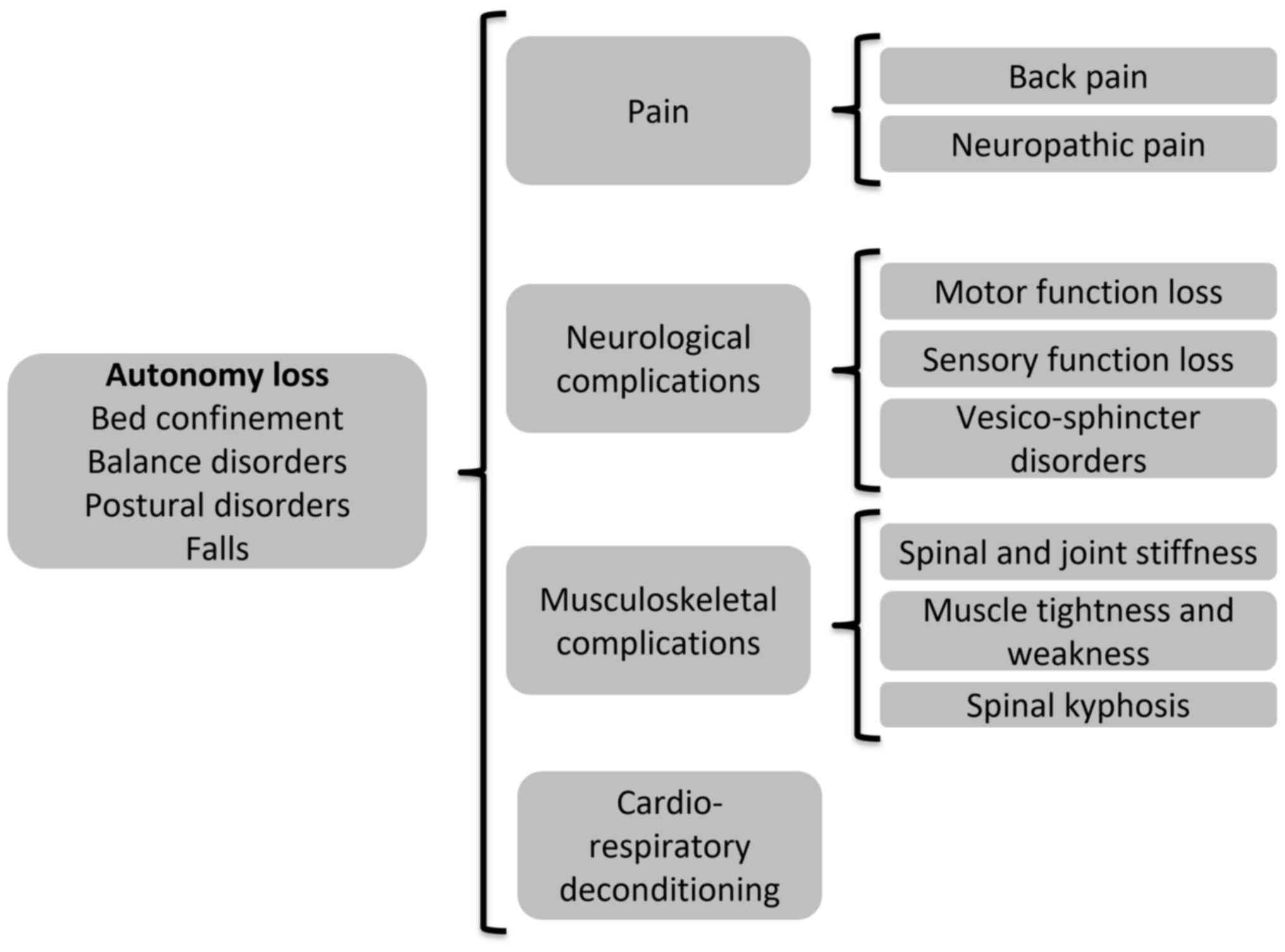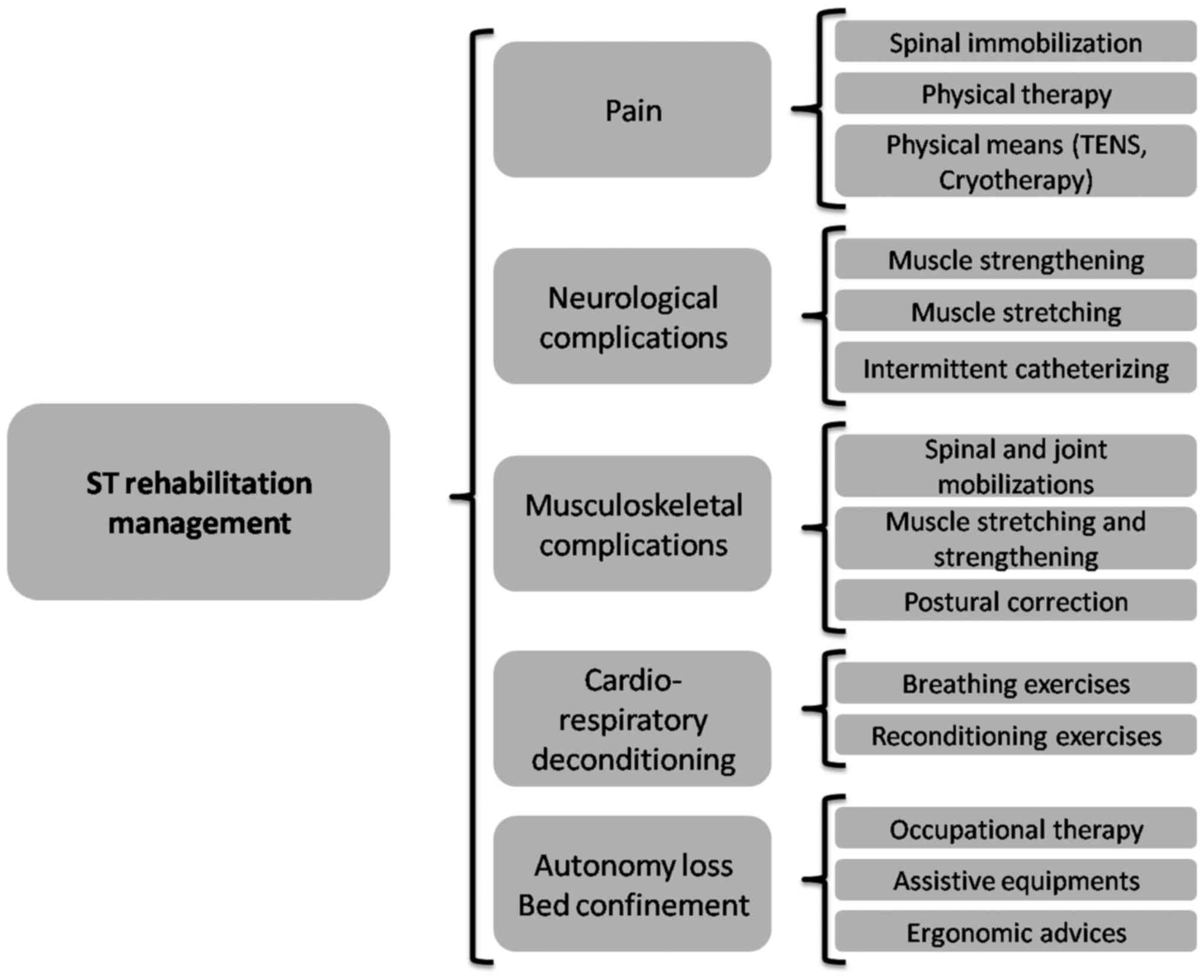
Rehabilitation management of patients with spinal tuberculosis (Review)
- Authors:
- Jaouher Dhouibi
- Amine Kalai
- Amr Chaabeni
- Ahlem Aissa
- Zohra Ben Salah Frih
- Anis Jellad
View Affiliations
Affiliations: Department of Physical Medicine and Rehabilitation, Faculty of Medicine, University of Monastir, Monastir 5000, Tunisia, Regional Hospital of Enfidha, Sousse 4030, Tunisia
- Published online on: April 4, 2024 https://doi.org/10.3892/mi.2024.152
-
Article Number:
28
-
Copyright : © Dhouibi
et al. This is an open access article distributed under the
terms of Creative
Commons Attribution License [CC BY 4.0].
Metrics: Total
Views: 0 (Spandidos Publications: | PMC Statistics: )
Metrics: Total PDF Downloads: 0 (Spandidos Publications: | PMC Statistics: )
This article is mentioned in:
Abstract
Spinal tuberculosis (ST) is a serious condition and a global health concern, accounting for a significant portion of musculoskeletal tuberculosis cases. It can lead to sever spinal and neurological complications. The management of ST involves a multidisciplinary approach, including medical treatment, surgery and rehabilitation. Rehabilitation is crucial through the course of the disease's and is tailored for each stage according to the patients' complaints, and clinical and functional complications. In the case of neurological issues due to spinal compression, rehabilitation aims at overcoming bed confinement complications, involving mobilization techniques, strengthening exercises and related vesico‑sphincter disorders (urodynamics, catheterizing). The role of rehabilitation for the management of pain in patients with ST is based on bracing (restricting movements and relieving the pressure on harmed structures), and analgesic physical means (electrical stimulation and massage techniques). Several rehabilitation options may be used to address musculoskeletal complications. Range of motion exercises, muscle strengthening, and posture and balance correction using sensory perception and proprioception techniques, are commonly involved. Cardiorespiratory reconditioning is required to improve respiratory function, walking ability and cardiovascular endurance. Ultimately, rehabilitation allows for the minimization of disability and the prevention of the loss of autonomy, particularly in elderly patients. The advantage of the rehabilitation approach is its multi‑optional characteristics including physical therapy, occupational therapy, ergonomic advices and assistive equipment. Despite its crucial role, rehabilitation remains understudied in the management of ST. Thus, the present mini‑review aimed to address the rehabilitation options for the clinical features and complications of ST, according to the course of the disease.
View References
|
1
|
Garg D and Goyal V: Spinal tuberculosis
treatment: An enduring bone of contention. Ann Indian Acad Neurol.
23:441–448. 2020.PubMed/NCBI View Article : Google Scholar
|
|
2
|
Dunn RN and Ben Husien M: Spinal
tuberculosis: Review of current management. Bone Joint J.
100-B:425–431. 2018.PubMed/NCBI View Article : Google Scholar
|
|
3
|
Rahim Khan S, Ahmad A, Saqib M and
Iftikhar M: Cervical Pott's disease presenting as quadriplegia in a
young patient: A case report. Cureus. 15(e46949)2023.PubMed/NCBI View Article : Google Scholar
|
|
4
|
Heyde CE, Lübbert C, Wendt S, Rodloff A,
Völker A and von der Höh NH: Spinal tuberculosis. Z Orthop Unfall.
160:74–83. 2022.PubMed/NCBI View Article : Google Scholar : (In English,
German).
|
|
5
|
Leowattana W, Leowattana P and Leowattana
T: Tuberculosis of the spine. World J Orthop. 14:275–293.
2023.PubMed/NCBI View Article : Google Scholar
|
|
6
|
Goyal R and Parakh A: Post-tuberculosis
sequelae in children. Indian J Pediatr: Nov 20, 2023 (Epub ahead of
print).
|
|
7
|
Jasiewicz B and Helenius I: Tumors and
infections of the growing spine. J Child Orthop. 17:556–572.
2023.PubMed/NCBI View Article : Google Scholar
|
|
8
|
Negrini S, Meyer T, Arienti C, Kiekens C,
Pollock A, Selb M and Stucki G: 3rd Cochrane Rehabilitation
Methodology Meeting participants. The 3rd Cochrane rehabilitation
methodology meeting: ‘Rehabilitation definition for scientific
research purposes’. Eur J Phys Rehabil Med. 56:658–660.
2020.PubMed/NCBI View Article : Google Scholar
|
|
9
|
Kirshblum S, Snider B, Rupp R and Read MS:
International Standards Committee of ASIA and ISCoS. Updates of the
international standards for neurologic classification of spinal
cord injury: 2015 and 2019. Phys Med Rehabil Clin N Am. 31:319–330.
2020.PubMed/NCBI View Article : Google Scholar
|
|
10
|
Zaoui A, Kanoun S, Boughamoura H, Ben
Maitigue M, Bouaziz MA, Khachnaoui F and Rejeb N: Patients with
complicated Pott's disease: Management in a rehabilitation
department and functional prognosis. Ann Phys Rehabil Med.
55:190–200. 2012.PubMed/NCBI View Article : Google Scholar
|
|
11
|
Na S, Lyu Z and Zhang S: Diagnosis and
treatment of skipped multifocal spinal tuberculosis lesions. Orthop
Surg. 15:1454–1467. 2023.PubMed/NCBI View
Article : Google Scholar
|
|
12
|
Mandhane KS, Phansopkar P and Chitale NV:
Physiotherapy rehabilitation of a conservatively managed patient
with Pott's disease: A case report. Cureus.
15(e33815)2023.PubMed/NCBI View Article : Google Scholar
|
|
13
|
Ahuja K, Gupta T, Ifthekar S, Mittal S,
Yadav G and Kandwal P: Variability in management practices and
surgical decision making in spinal tuberculosis: An expert
survey-based study. Asian Spine J. 16:9–19. 2022.PubMed/NCBI View Article : Google Scholar
|
|
14
|
Boussaid S, M'rabet M, Rekik S, Jammali S,
Rahmouni S, Zouaoui K, Sahli H and Elleuch M: Spinal tuberculosis:
Features and early predictive factors of poor outcomes. Mediterr J
Rheumatol. 34:220–228. 2023.PubMed/NCBI View Article : Google Scholar
|
|
15
|
Bettany-Saltikov J, Turnbull D, Ng SY and
Webb R: Management of spinal deformities and evidence of treatment
effectiveness. Open Orthop J. 11:1521–1547. 2017.PubMed/NCBI View Article : Google Scholar
|
|
16
|
Defi IR, Hamam NR, Biben V and Al Barqi
NC: Improving functional outcomes and quality of life in an elderly
woman with sarcopenia and spinal tuberculosis: A case report. Front
Rehabil Sci. 4(1076010)2023.PubMed/NCBI View Article : Google Scholar
|
|
17
|
Basso-Vanelli RP, Di Lorenzo VA, Labadessa
IG, Regueiro EM, Jamami M, Gomes EL and Costa D: Effects of
inspiratory muscle training and calisthenics-and-breathing
exercises in COPD with and without respiratory muscle weakness.
Respir Care. 61:50–60. 2016.PubMed/NCBI View Article : Google Scholar
|










